Introduction:
The full frame and crop frame are terms to describe the size of the digital sensor in a DSLR camera. The full frame term refers to a sensor size that has the same dimensions as the 35 mm film format (24 mm x 36 mm). The obvious question is, why it is called the full frame, the 35 mm film format has been the standard in film gauge since 1909 due to its good balance of cost and image quality and has stuck ever since.
At the beginning of the production of the digital camera (DSLR), and due to technical difficulties and production costs, making a digital camera with a sensor size that matches the size of 36 films was impractical, so camera producers started with a smaller sensor to allow for smooth transition from film to digital camera.
What is the crop factor?
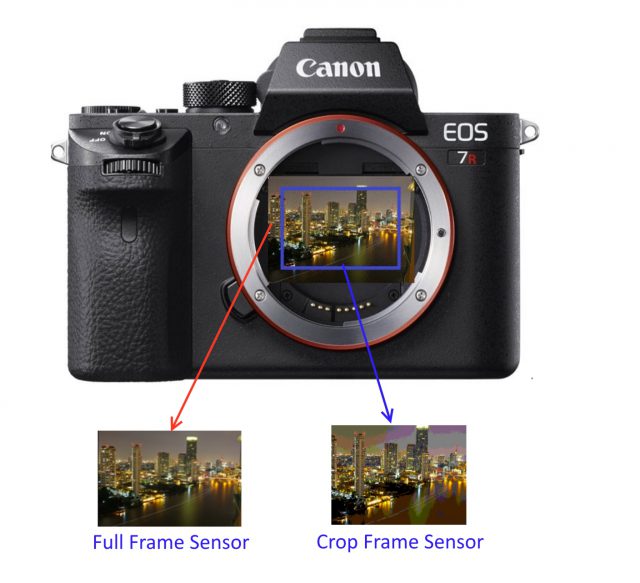
Lenses project a circular image (usually referred to as an “image circle”), but the sensor only records a rectangular portion of the scene – the rest of the image is thrown away. If the sensor area matches the area of the 35 mm film, it is called a “full-frame sensor” and if it covers a smaller portion that throws away or crops part of the image, it is called a “crop sensor”.
Full-frame sensors have the same physical size as 35 mm film (36 mm x 24 mm), while crop sensors are smaller and can vary in size depending on the system and manufacturer.
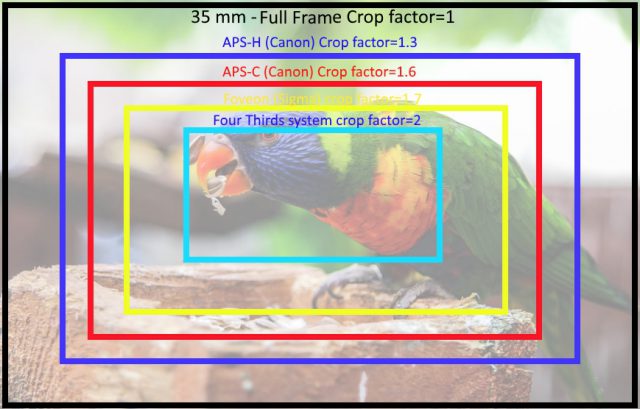
The crop factor is defined as the result of dividing the full frame diagonal length by the diagonal length of the crop sensor.
Here is an illustration of some sensor sizes.
| Sensor Type | Diagonal (mm) | Width (mm) | Height (mm) | Area (mm2) | Crop factor |
|---|---|---|---|---|---|
| Full Frame | 43.2 | 36 | 24 | 860 | 1 |
| Canon APS-H | 34.4 | 28.7 | 19 | 545.3 | 1.3 |
| Canon APS-C | 26.7 | 22.2 | 14.8 | 329 | 1.6 |
| Four third system,4/3 | 21.6 | 17.3 | 13 | 225 | 2 |
Effect of crop sensor on camera setting:
Now we will discuss the effect of crop sensors on some elements of camera settings:
-
Equivalent Focal Lengths
When introducing the crop sensor to the market the manufacturers of digital cameras also introduce the term “Equivalent focal length” which means the field of view equivalence. It was important to let people know that a 50 mm lens will give a narrower field of view on a crop sensor camera, similar to 75 mm lens on a 35mm film/full-frame camera. They also provide a formula to calculate the equivalent focal length by using the crop factor. It is rather a simple formula, take the focal length of the lens and multiply it by the crop factor, and you will get the equivalent focal length.
However, over time, it created a lot of confusion, especially among beginners. Some people started to say things like “This photo was taken at 450 mm focal length”, but it was taken at 300 mm lens mounted on a cropped sensor camera, Thinking that this setup was giving them a longer focal length, while in fact, all it did was giving them a narrower field of view due to sensor cropping the image frame. Let us remind you of the fact that the focal length of a lens never changes no matter what camera it is mounted on.
-
ISO and Exposure
Before the digital cameras, ISO was defined as the sensitivity of the film to available light, if you are shooting at daylight a film with a sensitivity of 100 looks OK, but when shooting in low light conditions, you had to change out the film to a higher sensitivity, say ISO 400 or even more. However, digital sensor acts differently than film, as there is no varying sensitivity to different light. Digital sensors only have one sensitivity level. Changing ISO simply amplifies the image signal, so the sensor itself is not getting any more or less sensitive. This results in shorter exposure time and more brightness, but with the penalty of added noise.
-
Depth of field
When using a rather big crop factor sensor, what would the image look like? , if we use for example the much smaller Micro Four Thirds camera that has a 2.0x crop factor, the field of view of a 50mm lens would make the subject appear twice closer as if we were using a 100mm lens, as illustrated in the below image.
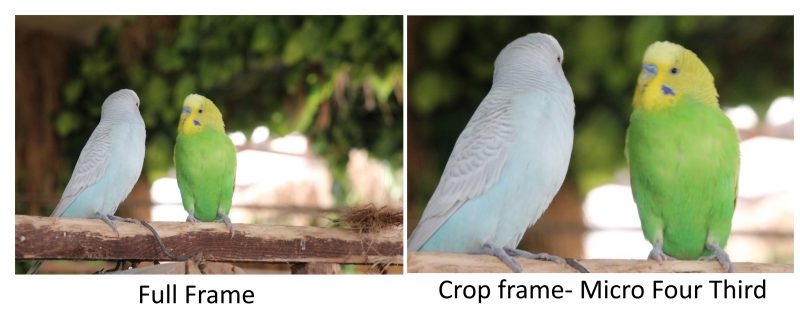
The advantage of Full frame camera
- Larger pixels
Full-frame camera sensors have larger pixels. This means they create images with less noise and all-around better image quality
- The Depth of field
The sensor size affects the apparent depth of field. Since the full-frame sensor is larger than the crop sensor, it can perform a shallower depth of field than the crop sensor when using the same lens.
- More megapixels
Full-frame cameras usually have more megapixels. While this doesn’t matter to most photographers, it may be useful if your client demands large images or you want to make large prints.
- Low light performance
Digital sensors have tiny little light sensors that record light and produce pixels, they are called photosites. The larger the photosites, the more ability it has to capture weak light signals. Therefore, when other factors are the same, a full frame sensor will always perform with less noise at high ISO than the crop sensor.
- Viewfinder brightness
Because full-frame camera uses larger lenses, they can produce brighter viewfinder images.
Finally, famous digital camera producers consider the full frame bodies as suitable cameras for professional photographers, so they used to add more options and settings to them, Unfortunately, they do not add these options to crop sensor cameras.
Disadvantages of Full frame camera
- The cost
- Due to manufacturing process costs, the full frame camera is always more expensive than the crop sensor camera.
- The weight
- The full-frame sensor adds nothing to the weight of the camera, but the full-frame camera is much heavier because of the weight of the lenses that are used with it,
- Lens availability
- Full-frame lenses will work properly on both full-frame and crop-frame DSLR cameras, but the reverse is not true. There, crop sensor cameras have a greater variety of lenses available for them.
Full Frame vs. Crop – Which To Choose
If you are thinking of buying a new camera, please consider the following factors:
- Existing lenses compatibility
You should consider your current lenses and make sure that they are going to match the new camera. Some lenses are designed for crop sensor cameras and won’t work with full frame. Does upgrading to a full frame mean that you will also have to spend money on new lenses?
- Size and weight
Despite the advances in mirrorless cameras, the digital SLR design is still the best for most types of photography. The trade-off is the size and weight, as digital SLRs are bigger and heavier than other types of cameras. Size and weight are important factors if you like to travel with your cameras, but maybe not so important if you take most of your photos locally.
- Budget
This is important for fairly obvious reasons. Don’t be afraid to buy a crop sensor camera if your budget doesn’t stretch to full frame.
Thank you for reading this post, I hope you found it useful and helpful, If you have any questions or comments, please write it in the box below, I will be glad to respond.
If you enjoy the site, don’t forget to subscribe, we will only inform you when a new article is posted.





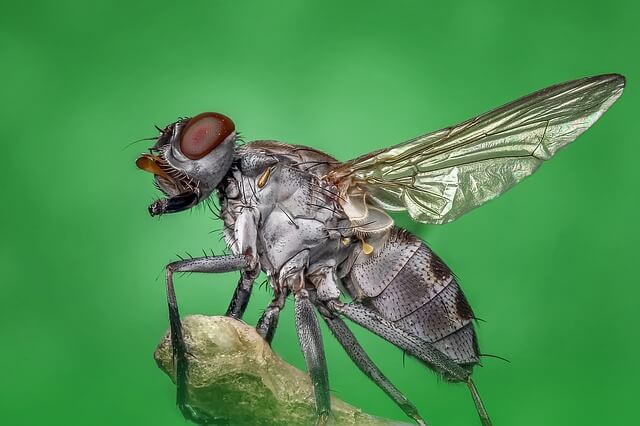
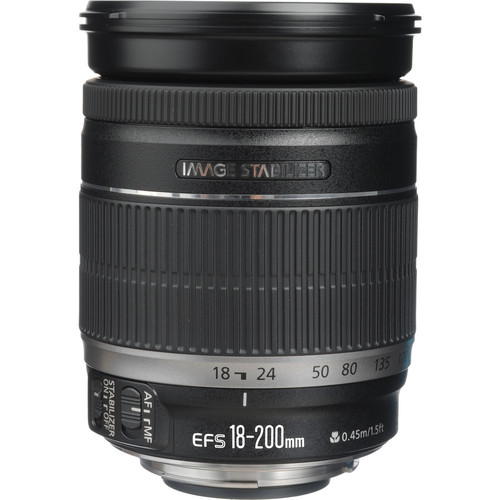
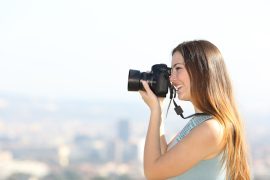


I am new to photography as far as it goes trying to do it professionally.
I’m obviously not new to taking pictures but I have realized that there is so much more to taking pictures than just taking them.
Anyways that is how I found myself here. I am trying to learn all I can about this art so that I can really make a go of it.
Such as the terminology and different techniques there are and which is the best to use for each situation.
Then again I could just be over thinking it but either way there is still quite a bit that I need to learn.
Which brings me to my question.
What do you believe to be the best camera for a beginner to use starting out?
Keep in mind that this is something that I am hoping to get paid for.
Thank you in advance for the advice.
Hi Jason
Thank you for your comment, you asked a very tough question!!, It is all about your budget and then about what types of photography you are going to take, because that will defines the appropriate lens. As a Canon lover I suggest reviewing this post https://canonlensesforlandscape.com/top-5-canon-dslr-cameras/ , you will find a review of the top canon DSLR cameras. You may choose the one that suits your budget. Good luck .